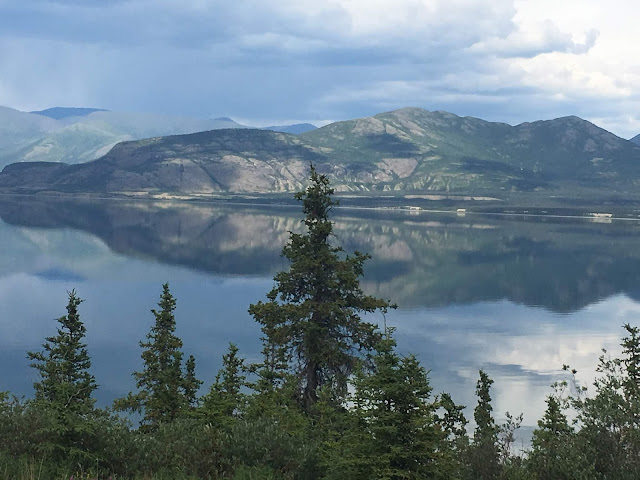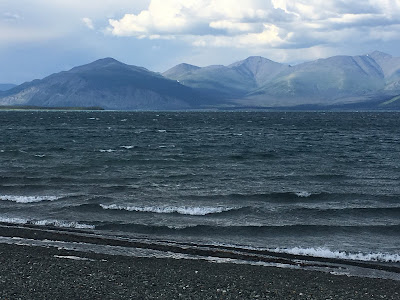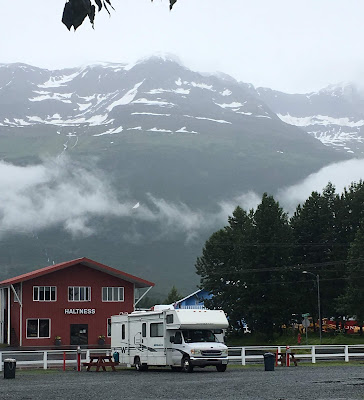We were stopped at the BC border for a search by a very nice young lady who checked our rig and car and proclaimed we could go on. Whew!
Even though we had been on this highway before, we were still mesmerized by the views of glaciers and the incredibly gorgeous, fast moving rivers. We headed towards Kluane National Park in the Yukon and couldn't get over the beauty here either. Wondering if you lived here, would you just take the beauty for granted? We just can't get over it. We drove the road around Kluane Lake, never seeing another soul and very little in the way of a house or shack of any kind. We learned that 300 or 400 years ago, the lake completely changed its course when a glacier closed its drainage outlet, raising the lake 30 feet and causing it to run south to the Gulf of Alaska and northeast to the Yukon River.
 |
| It was as smooth as glass when we arrived. The fireweed just enhanced the beauty of the area. |
 |
| Look at that water! And how about the colors in the hills!? |
We ended up at an absolutely fabulous place called Cottonwood RV Park. The front area, looked just like a normal RV park and it was pretty crowded-apparently with caravans of people that travel together with similar RVs. The owner said that if we didn't mind dry camping he had an area he thought we might like. It was Nirvana-we might never have left if a huge wind and rain storm didn't move in and keep us inside. And, we still had the problem with the toilet and the bathrooms were a good 1/4 mile down the road.
 |
| Can you beat this for a view!!?! We made some tequila cocktails and sat out for about an hour before the storm moved in. |
 |
| Check out our nearest neighbors, sitting way down the beach! |
 |
| The storm has begun! |
 |
Maxine is back in the trees, thank goodness. So, the winds didn't keep
us from a good night's sleep! The weather is still ok here. |
 |
The storm rolled in and we grabbed everything before it ended
up on the opposite shore! |
The next day we headed toward the Alaska border on the Alcan. You hear so much about the Alaska Highway, but really, it is not in the best of shape (as is true, as we get closer to the border, of other main highways up here). It suffers from frost heaves, pot holes and inconsistency. You never know what the next section of the highway will be like.
 |
| This is what alot of it looks like. |
We traveled through the Kluane Wildlife Sanctuary, where we saw a grizzly cross right in front of us.
The Tanana valley is one of the largest IBAs in the US. This Important Birding Area is of global importance as it is essential for the breeding, wintering and migration of lots of species and in particular, of trumpeter swans and sandhill cranes. We saw both species while we were here.
 |
They call this area the Taiga, or Land of Little Sticks. It is like a
boreal forest, very spongy, with small, skinny, dark black spruce trees. |
We didn't like the name but wanted a quiet spot and decided to stay at Deadman's Campground which is a US Fish and Wildlife area. It is in the Tetlin National Wildlife Refuge. It was wonderful. There was alot of privacy at our campsite; they had a good clean bathroom (now, quite important); a gorgeous lake; campfire programs; and a lovely boardwalk nature trail. Remarkably, they also had canoes and life vests for campers to use. The only noise besides the sounds of birds is the occasional landing of a seaplane.
 |
| Dreaming of fishing |
The nature trail was very interesting to us. This taiga forest is especiallly vulnerable to warming climate. Global warming dries these wetlands, encourages invasive plants to grow here and creates larger and hotter fires which melt the permafrost and create insect infestations. Its spongy, mossy soil insulates the frozen ground. Apparently, if you don't have permafrost the soils are not drained well enough. Alot of interesting plants:
 |
| Labrador Tea |
 |
| Cotton plant |
 |
| You can see why they call it "Land of Little Sticks". |
 |
| Beautiful lily pads in the lake |
This area is a haven for wildlife. Semi nomadic Athabascans settled here. There are so many creeks and lakes, and rivers that it attracts the first of migrating birds. The extended sunlight stimulates plant growth. This land feels rich in many ways.
 |
| Sunset (about midnight?) |
 |
Jim got up early and drove down the road to a place
where he could get a fishing license. He had a
great time paddling and fishing in this beautiful lake. |
 |
| From our campsite |
I went to a talk about beading from an Athabaskan woman. She does beading and then puts them (moccasins, hair clips, patches, etc.) in her "treasure box" to give at potlatch. Some of them are on plastic backing that she buys at a store and others are on moose hide that her aunt tans. Her tribe only has a potlatch for a family who has lost a loved one. A family from the opposite clan holds a potlatch for the family of the deceased to thank them for helping with the arrangements for the deceased. Her family lives on subsistence farming. She says this year has been difficult as the King Salmon, which they like best has been pretty fished out (some kind of problem with spawning).
We had a big fire after the talk, cocktails and then a nice salmon dinner. We were in bed by midnight. Our bodily rhythms seem to be adjusting to the light. In Mexico we are in bed by 9, whereas here, we are in bed some time about midnight.
We left on the Alcan again. Heading for Tok and down the Cut off to the Richardson Highway to Valdez.































































